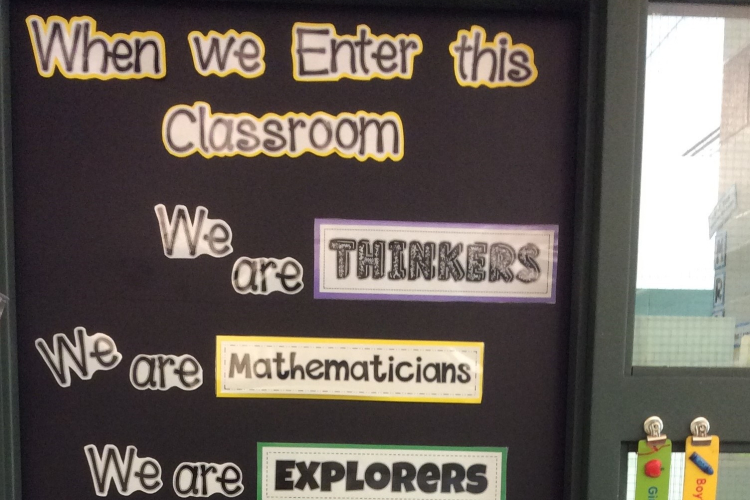Cultivating a Culture of Critical Thinking

To equip students for the demands of the 21st century global arena, educators today are faced with the task of not only helping their students master core academic content but also develop their ability to critically evaluate the world around them, define problems, and find solutions. This requires moving students from being consumers of knowledge to thinkers who can transfer their knowledge, understanding, and skills to new situations, now and in the future.
As an educator in the trenches, seeking to develop lessons that met the increased rigor of these expectations, I quickly realized that I needed to move my students away from the “game” of school that they were comfortable with – having the right answer, pleasing the teacher, getting good grades, and appearing “smart” in front of their peers. Helping them achieve their individual potential and become all God intends for them required an increased focus on developing students’ thinking dispositions. The portrait of a learner I sought to develop was an active and engaged thinker, able to communicate, innovate, collaborate, problem solve, experiment, take risks, and be resilient. The journey I embarked on transformed my educational practice and the culture of my classroom.
Thinking is difficult mental work that involves taking risks. The culture of the classroom, therefore, is foundational. Critical thinking skills (observation, analysis, interpretation, reflection, evaluation, inference, explanation, problem solving, and decision making) are learned through being immersed in a culture where thinking is valued over the correct answer, mistakes are expected, and students respectfully question each other’s conjectures. Creating a culture of thinking requires every member to play a role, with the teacher guiding that culture. And as guides in this process, if we desire transformation in our students, we must first be transformed ourselves – becoming a student of ourselves as thinkers and transforming our instructional practices to value and actively promote thinking.
How can we actively develop a critically thinking classroom culture? Here are some ideas:
Create Opportunities for Students to Think
Taking our cue from the master teacher, we see that Jesus valued and actively developed thinking in His disciples, followers, and friends, as well as the Pharisees. Repeatedly, He created opportunities for thinking. Why? He knew that learning is a constructive activity that learners themselves have to carry out. Knowledge and understanding cannot be forced upon or transferred from the mind of one knower to another. In His “lessons,” He was masterful at using questioning strategies to draw out reasoning and evidence, promote curiosity, and help facilitate making connections to prior knowledge. We see Him respond to questions with evidence, versus an “answer,” leaving hearers to reason and form conclusions. His use of parables challenged hearers to consider different viewpoints, uncover complexities, and capture the heart of the lesson objective. Likewise, we need to be intentional and strategic so that our classroom reflects what we value and produces the desired outcomes.
 If we value thinking, then we must provide on-going opportunities for our students to develop, practice, and refine their thinking skills. We do this through shifting away from teacher-centered, direct instruction and tasks that require memorization and rote learning of facts and procedures. Rather, we provide a student-centered, inquiry and problem-based approach that utilizes rich tasks, prompts, and questions that students must grapple with, thus placing them in the role of scientists, mathematicians, writers, geographers, and historians. Our role becomes that of a facilitator - successfully drawing out students’ thinking and helping them make connections. This requires making students’ thinking visible and deepening content learning through effective questioning strategies, productive student discourse, and thinking routines.
If we value thinking, then we must provide on-going opportunities for our students to develop, practice, and refine their thinking skills. We do this through shifting away from teacher-centered, direct instruction and tasks that require memorization and rote learning of facts and procedures. Rather, we provide a student-centered, inquiry and problem-based approach that utilizes rich tasks, prompts, and questions that students must grapple with, thus placing them in the role of scientists, mathematicians, writers, geographers, and historians. Our role becomes that of a facilitator - successfully drawing out students’ thinking and helping them make connections. This requires making students’ thinking visible and deepening content learning through effective questioning strategies, productive student discourse, and thinking routines.
Make Student Thinking Visible – Questioning
Questioning sequences provide an opportunity for us to model our own thinking, curiosity and wondering to students. This can be done as simply as “I’m wondering...” and “What if...” Questioning sequences also assist in making students’ thinking visible in order to help construct understanding, and to facilitate, clarify, and extend student thinking. To draw out student thinking, try using an open-ended question as simple as, “What makes you say that?” to push students to reflect on, analyze, explain, and defend their thinking with reasoning and evidence. The use of questioning stems and questioning protocols are useful in developing student thinking and discourse in a supportive environment.
Make Student Thinking Visible – Student Discourse Students reach new heights through collaborative opportunities to make their thinking visible as they explain and justify their thinking and solutions to instructional tasks. Social interactions are an essential source of alternative views that challenge the student’s current thinking and create the stimulus for new learning. However, care must be taken to develop a classroom community of learners dedicated to learning from each other in a cooperative rather than competitive manner and which honors each member as an image-bearer of Christ. Involve students in collaboratively developing guidelines for what the classroom should “look” like, “sound” like, and “feel” like, for students to be able to think, share their thinking, and celebrate their thinking. Use these norms to model and clarify how to have academically productive conversations where students listen to understand, speak to be understood, and disagree without being disagreeable. In addition to modeling, it is helpful to provide accountable talk sentence stems that help students add or build on the ideas of others, ask clarifying questions, and provide feedback to other students that is constructive, specific, and kind. The regular use of discourse strategies and protocols is helpful to keep discussions focused and students on-task.
Students reach new heights through collaborative opportunities to make their thinking visible as they explain and justify their thinking and solutions to instructional tasks. Social interactions are an essential source of alternative views that challenge the student’s current thinking and create the stimulus for new learning. However, care must be taken to develop a classroom community of learners dedicated to learning from each other in a cooperative rather than competitive manner and which honors each member as an image-bearer of Christ. Involve students in collaboratively developing guidelines for what the classroom should “look” like, “sound” like, and “feel” like, for students to be able to think, share their thinking, and celebrate their thinking. Use these norms to model and clarify how to have academically productive conversations where students listen to understand, speak to be understood, and disagree without being disagreeable. In addition to modeling, it is helpful to provide accountable talk sentence stems that help students add or build on the ideas of others, ask clarifying questions, and provide feedback to other students that is constructive, specific, and kind. The regular use of discourse strategies and protocols is helpful to keep discussions focused and students on-task.
Make Student Thinking Visible – Thinking Routines
The use of thinking protocols provides tools and strategies that support the hard mental work of thinking and assist teachers in developing student thinking skills and dispositions. These protocols help students manage, organize, record, and recall their thinking and provide a means to share the products of their thinking. They are often considered “routines” as they are designed to be used over again in the classroom and become ingrained in the classroom culture. Both Harvard Project Zero’s (Ron Richhart) Visible Thinking Routines and Tony Ryan’s Thinker Keys are excellent resources to provide an entry point to develop, extend, and expand thinking in the classroom. A great place to start is using this set of simple core thinking routines that can be used at any point in a unit of study and are applicable for all content areas, topics, and age groups.
Your Turn
The development of a culture of thinking takes time, practice, and intentional planning. As you begin, ask yourself, What kind of thinking do I need students to do with this content? How can I best scaffold that thinking? What do I want to reinforce? To what do I call students’ attention? What will I do to model the thinking and expectations? How will I make my students’ thinking visible – to themselves, their peers, and myself? What language of thinking will I use to name the thinking expectations and notice and name the thinking I see in my students?
By creating opportunities for students to think and make their thinking visible, you can transform your classroom culture into a culture of critical thinking.
Diane Peneycad
Diane Peneycad has been a middle school educator, instructional leader, and educational consultant in the United States. She holds an MA in curriculum and instruction and an Ed.S in educational leadership. Diane has served on TeachBeyond’s Canada/US Board and Global Committee and now serves as the Associate Director of Global Organizational Development. Her role involves serving in a variety of ways to support our national entities, new schools, and global transformational education centres (GTECs). She enjoys mentoring teachers and supporting leaders.
Additional Resources:
Web:
Project Zero’s Thinking Routine Toolbox
[Note: Project Zero’s Thinking Routines are also available in Spanish at the above link.]
Thinking Pathways Educational Resources
Think From the Middle Strategy Toolbox
Books:
The Thinking Classroom - Alice Vigors
Creating Cultures of Thinking - Ron Richhart
Making Thinking Visible - Ron Richhart
Photo Credits
Door Decor. D. Peneycad. Resized.
Peel the Fruit Thinking Routine. D. Peneycad. Resized.
Classroom Characteristics. A. Ferris. Resized.



